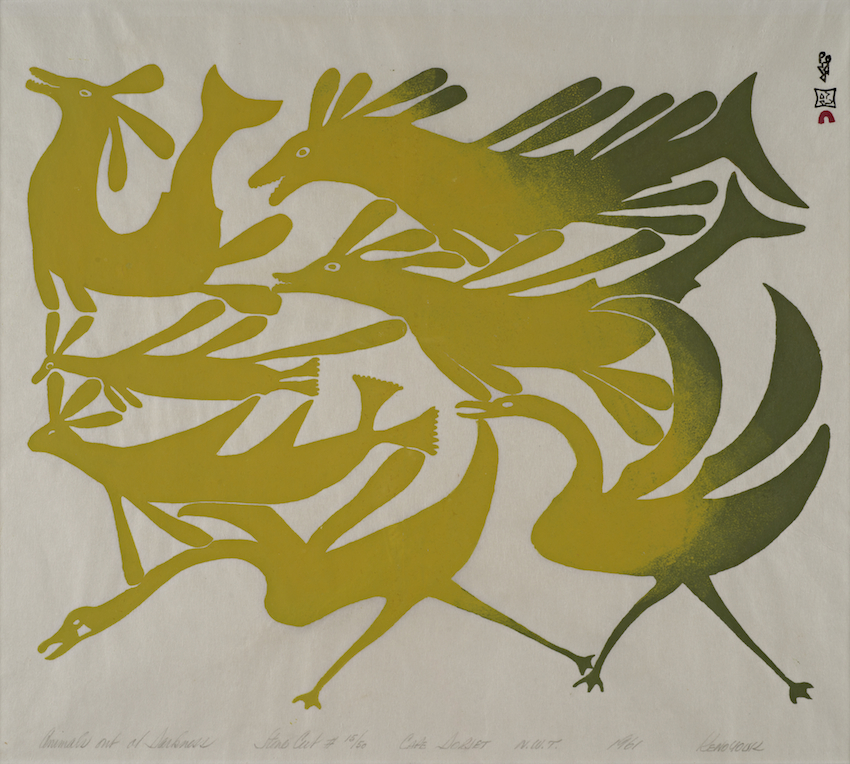
Kenojuak Ashevak (Inuit, Cape Dorset, Canada, 1927–2013) and Johnniebo Ashevak (Inuit, Cape Dorset, Canada, 1923–1972)
Animals Out of Darkness, 1961
Stonecut on paper, 5/50
19.5 x 21.75 inches
Reproduced with the permissions of Dorset Fine Arts
“There is no word for art. We say it is to transfer something from the real to the unreal…”
— Kenojuak Ashevak
Renowned Inuit printmaker Kenojuak Ashevak’s work Animals Out of Darkness brilliantly combines her signature artistic style and her unique worldview as an Inuit woman living in Cape Dorset, Nunavut. In this print she intertwines birds and animals in pictorial space, their bodies flowing across the page from right to left, creating a sense of movement. The mobility of Kenojuak’s creatures combined with the gradient of colors suggests an important narrative that brings the Inuit the promise of a summer. Her distinct use of birds is a theme seen throughout the entirety of her career, and she commonly depicts abstract animal shapes in many of her prints. She transforms these animals into creatures from her imagination – giving rabbits seal fins and seals bird feathers, adding to the overall sense of movement in the print. The flowing nature of her prints is also often due to the fact that while drawing the original outlines she does so without lifting her pencil.
Color is also an important factor in understanding the story of Animals Out of Darkness. While the animals stream across the surface of the print the color gradient also shifts from a dark green to bright yellow as if they are in a celebratory parade, leaving the darkness and returning once more to a world of light. Kenojuak alludes to the transition from winter darkness to summer sunlight and the impact of this cycle on the outlook and lifestyle of the Inuit of Nunavut. One of the best known Inuit stories is of how Crow stole the sun to bring light in a world of endless night. Kenojuak communicates the importance of light and shadow in Inuit culture; the solid forms of the animals, for example, also suggest shadow puppets used to compliment Inuit oral stories that narrate the unique dimensions of the Arctic experience.
Inuit people adopted printmaking when it was introduced to Cape Dorset in the 1950s, and Kenojuak quickly mastered the form. Throughout her career she has created prints like Animals Out of Darkness which communicate subtleties of Inuit culture to the greater world. The West Baffin printers co-op helped Kenojuak and her contemporaries form a financial support system for their families after the Canadian government colonized the Inuit nomadic way of life. Although the co-ops were almost always created by the Hudson Bay Company and its representatives and were therefore colonial institutions, they also facilitated the proliferation and distribution of contemporary Inuit work. Truly evocative of her era, Kenojuak’s career began in the late fifties and spanned five decades until her death in 2013. Animals Out of Darkness is highly characteristic of her signature style and an excellent example of why her work was among the greatest influences in defining a specific aesthetic of Inuit printmaking.
Nicholas Corda ’14 & Pilar Jefferson ’15
